
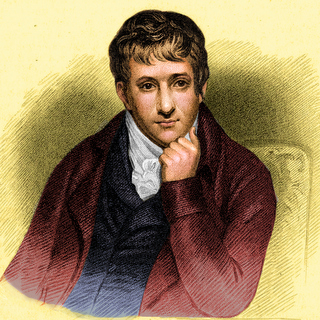 Humphry Davy
Humphry Davy
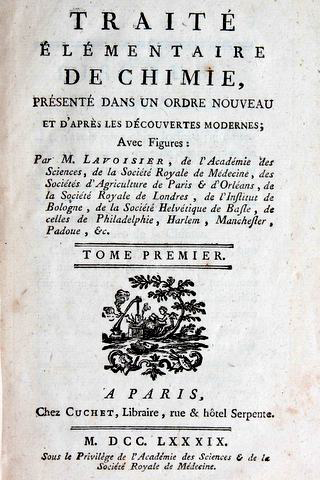 Davy taught himself chemistry by reading books like Antoine Lavoisier’s classic.
Davy taught himself chemistry by reading books like Antoine Lavoisier’s classic.
Self-Taught Scientist
By the end of the 18th century, the discovery of oxygen had triggered a worldwide search for new elements. One of the people who would be caught up in this race was a precocious chemist from the farthest reaches of England. Born in 1778, Humphry Davy would eventually rise to the very top of British science – knighted for his discoveries and named president of Britain’s leading scientific organization, the Royal Society. But he began life as the son of a simple wood-carver from the remote seaside village of Penzance, in Cornwall, about a week from London by stagecoach. When his father died young, Humphry left school at 16 and took a job as an apothecary’s apprentice to support the family. But he never lost his love of learning. He simply resolved to teach himself.
High on his reading list was Antoine Lavoisier’s new textbook, then sweeping the world of chemistry. Davy also performed his own experiments and – even at age 17 – was bold enough to take on the master himself. By rubbing two blocks of ice together, Davy showed that friction alone could melt the ice, challenging Lavoisier’s contention that heat was a material substance (“calorique”) and lending support to the modern idea that heat is caused by motion of particles.
Bristol Circle
The results of Davy’s early experiments, written up in his first published work, An Essay on Heat, Light and the Combinations of Light, showed enough promise to land him a new job closer to Britain’s center of action. At just 19, he left remote Penzance to become the assistant director, and then the director, of the Pneumatic Institution in Bristol. In these new, more cosmopolitan surroundings, he soon formed friendships with a group of literary men who shared his love of nature and poetry, including poets Samuel Taylor Coleridge and Robert Southey and publisher Joseph Cottle.
Film Clip: An Intellectual Explosion - When 17-year-old Humphry Davy reads Lavoisier’s textbook, it inspires a lifelong fascination with chemistry and prompts him to begin his own experiments.
Film Clip: Davy’s Literary Circle - After moving to Bristol at age 19, Davy falls in with a group of literary men, including poet Samuel Taylor Coleridge.
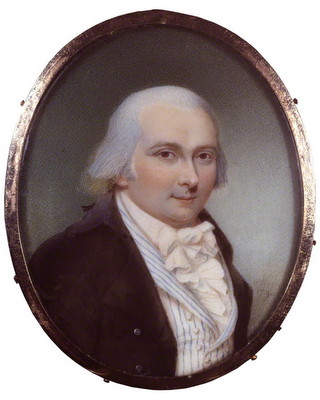 Dr. Thomas Beddoes, founder of the Pneumatic Institution
Dr. Thomas Beddoes, founder of the Pneumatic Institution
 Davy’s book on nitrous oxide helped land him a new job at the Royal Institution in London.
Davy’s book on nitrous oxide helped land him a new job at the Royal Institution in London.
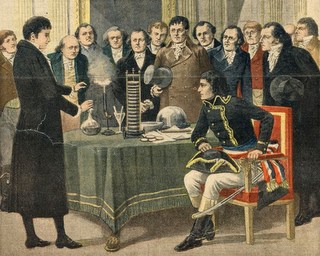 Alessandro Volta demonstrates his “voltaic pile” for Napoleon.
Alessandro Volta demonstrates his “voltaic pile” for Napoleon.
Fearless Experimenter
Dr. Thomas Beddoes had founded the Pneumatic Institution in 1799 in the hope that some of the gases that had been discovered by Joseph Priestley and others would prove useful in treating diseases. Davy’s job was to make the gases and test their physiological effects. He approached the task with abandon, using himself as guinea pig. “He doesn’t know exactly what it is, but he makes it, and he tests everything on himself,” says biographer Richard Holmes. “It’s amazingly reckless, but it’s also very brave. On a number of occasions, he does nearly kill himself.”
Laughing Gas
Even at this early age, Davy had set a goal of reaching the very pinnacle of science. On one page of his Bristol notebooks, he wrote his own name next to that of the greatest British scientist who had ever lived: Isaac Newton. For the rest of his life, he would be driven to become the Newton of chemistry.
That quest for greatness would receive a big boost from his studies of a gas that would bring him to the attention of the world – nitrous oxide. Davy discovered that breathing in this gas gave people a powerful feeling of giddiness. As word spread, Davy’s literary friends and many others -- from steam engine pioneer James Watt to the king’s own doctor – clamored to try his “laughing gas.” Breathing it became a popular form of entertainment across England.
A New Obsession: Electricity
Davy asked each of his subjects to record their impressions of nitrous oxide, and he wrote up their accounts in his first true scientific book: Researches, Chemical and Philosophical, Chiefly Concerning Nitrous Oxide and its Respiration. But just as he was finishing the book, Davy’s attention was diverted by a discovery that would shake the very foundations of science: Alessandro Volta’s invention of the voltaic pile – the first battery.
Up to then, the only sources of electricity had been lightning, which was very difficult to tap, and electrostatic devices of the kind Joseph Priestley and Benjamin Franklin had used. These machines could generate powerful sparks and shocks, but they couldn’t produce a sustained electrical current. Volta’s pile did, and the experiments it made possible quickly made electricity Davy’s new obsession.
Film Clip: Fearless Experimenter - Charged with exploring the potential health effects of newly discovered gases, Davy tests each gas on himself, nearly killing himself several times.
Film Clip: Laughing Gas - When Davy discovers that one of the gases he tests makes people deliriously happy, inhaling “laughing gas” becomes a popular form of entertainment. Film Clip: The First Battery - When Alessandro Volta invents the battery in 1800, Davy drops his research on gases. Electricity becomes his new obsession.
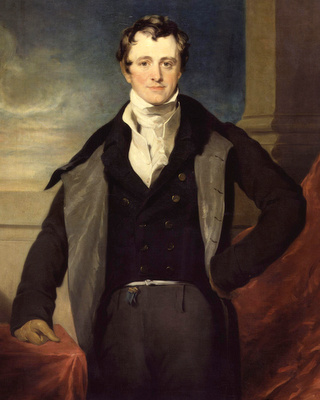 Davy at the Royal Institution
Davy at the Royal Institution
 Hoping to use the battery to discover new elements, Davy set out to break down caustic potash, a substance derived from ashes collected in a pot.
Hoping to use the battery to discover new elements, Davy set out to break down caustic potash, a substance derived from ashes collected in a pot.
Scientist as Public Figure
Davy had just begun to explore the new “promised land” of electricity when opportunity knocked. His book on nitrous oxide had caught the attention of the founders of the new Royal Institution in London. They were looking for a director for their chemistry laboratory, and after reading Davy’s precise, quantitative study of nitrous oxide, they thought: “This is the man we must get.” Still only 22, Davy set out on his next great adventure, leaving Bristol in 1801 for the city he called “the great hot-bed of human power.” Within five years, he would be one of the most famous chemists in the world, thanks largely to his popular lectures, which drew hundreds of adoring fans and brought London traffic to a standstill. His work at the Royal Institution made Davy the first scientist to become a major public figure, and he made it his mission to inspire the public about the benefits of science – a mission that many other scientists have taken up since then.
Finding New Elements
Davy’s success as a lecturer and entertainer brought him wealth, prizes, and acclaim. But he was growing impatient. Giving popular lectures was no way to become the Newton of chemistry. By 1806, though, the income from his lecture series had become so critical to the Royal Institution’s financial survival that he could demand time to do his own work. An invitation to lecture at the prestigious Royal Society – an organization once headed by Newton himself – gave Davy the perfect opportunity to show what he could do. Needing to produce some dramatically original science, Davy dived into the subject he’d been itching to return to ever since Bristol: electricity.
Just weeks after the news of Volta’s battery arrived in London, two British scientists had used the voltaic pile to split water into its two elements: hydrogen and oxygen. Now Davy built a huge battery in the basement of the Royal Institution, hoping to use it to pry apart other substances that were harder to break down. For his first experiment, he chose caustic potash, a substance derived from wood ashes collected in a pot. After several failed attempts, Davy succeeded in splitting potash apart, revealing the shining globules of a new metal: potassium. The very next day, he broke down soda to reveal another new element: sodium.
By using his battery to discover potassium and sodium, Davy had turned electricity into a powerful new tool in the search for elements. The following year, he used his battery to isolate four more elements: barium, calcium, magnesium and strontium. And chemists all over Europe seized on his technique, discovering aluminum, boron, iodine, lithium and silicon. “Nothing,” Davy observed, “promotes the advancement of science so much as a new instrument.”
Video: Davy’s Greatest Invention – As a wildly popular lecturer at London’s Royal Institution, Davy becomes chemistry’s first great showman and creates the role of scientist as public figure.
Film Clip: New Elements – Eager to do some truly original science, Davy builds a huge battery and uses it to discover two new elements: potassium and sodium.
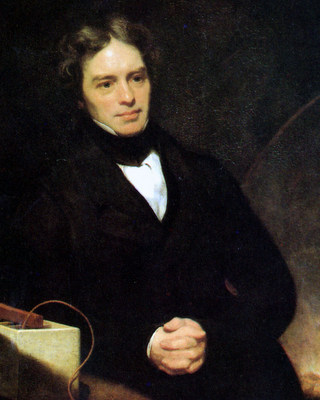 Davy’s protégé, Michael Faraday, would go on to explore the role of electricity in matter.
Davy’s protégé, Michael Faraday, would go on to explore the role of electricity in matter.
 Davy’s failure to capitalize on his discovery of anesthesia doomed thousands to needless surgical pain.
Davy’s failure to capitalize on his discovery of anesthesia doomed thousands to needless surgical pain.
Electric Glue
Exciting as these discoveries were, in time it would become clear that Davy’s greatest contribution was his insight into the role electricity plays in binding elements together into the matter that surrounds us. “Somehow the particles of matter have to be glued together to form molecules,” says biographer David Knight of Durham University. “And it was a complete mystery as to what this glue might be. What Davy has, in effect, is a big idea.”
“Is electricity an essential property of matter?” Davy wondered.
Until 1800, electricity had been mostly about parlor tricks, like making people’s hair stand on end, Knight explains. “Davy showed that electricity is a fundamental aspect of matter. Electricity is what holds us together. It is the glue that links the particles of matter. And, therefore, instead of being rather a side thing, electricity is going to be one of the really central features of science.”
It would take other scientists, including Davy’s protégé, Michael Faraday, more than a century to figure out electricity’s role. But after Davy, there was no doubt it would be one of the keys to solving the mystery of matter.
A Missed Opportunity: Anesthesia
One day, after breathing nitrous oxide, Davy noticed that the toothache he’d been suffering from had vanished. It occurred to him that laughing gas might be used to eliminate the pain of surgery – what we now call anesthesia. But he never followed up on the idea, his attention diverted first by Volta’s discovery of the battery, and then by the demands of his new job at the Royal Institution. It would be another 40 years before American doctors first used ether as an anesthetic – 40 years in which countless patients around the world suffered pain they could have been spared if Davy had followed up on his own discovery. Biographer Richard Holmes calls it “Davy’s greatest failure as a scientist.”
Video: Electricity and Matter – Humphry Davy was the first to sense that electricity is an essential property of matter, but it took more than a century for other scientists to figure out how electricity serves as the glue that holds all matter together.
Video: Davy's Greatest Failure - With his attention diverted by electricity, lecturing and discovering new elements, Davy fails to follow up on own observation that nitrous oxide dulls pain, delaying the use of anesthesia and condemning thousands to decades of needless surgical pain.
Want to Learn More?
To see the full Davy story, select Watch Online to go to pbs.org/mysteryofmatter and watch Episode 1. Or click on Buy to purchase the series DVD at ShopPBS. For more resources about Humphry Davy’s life and career, select Learn More.